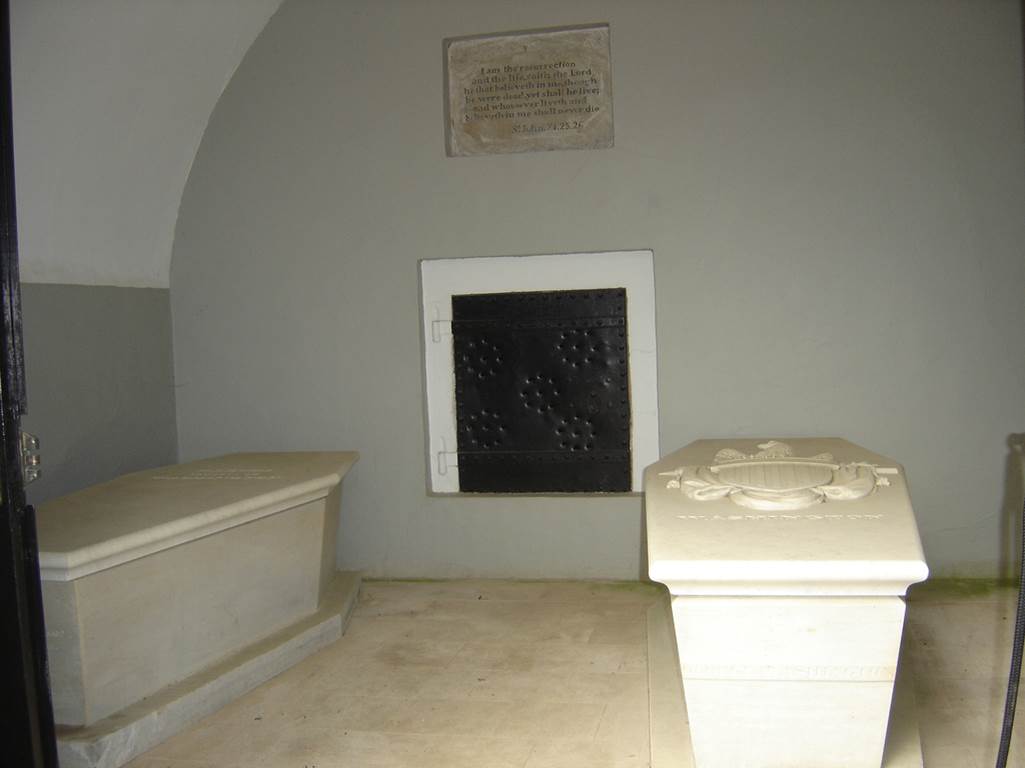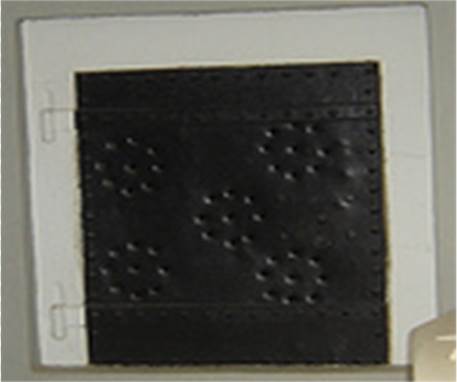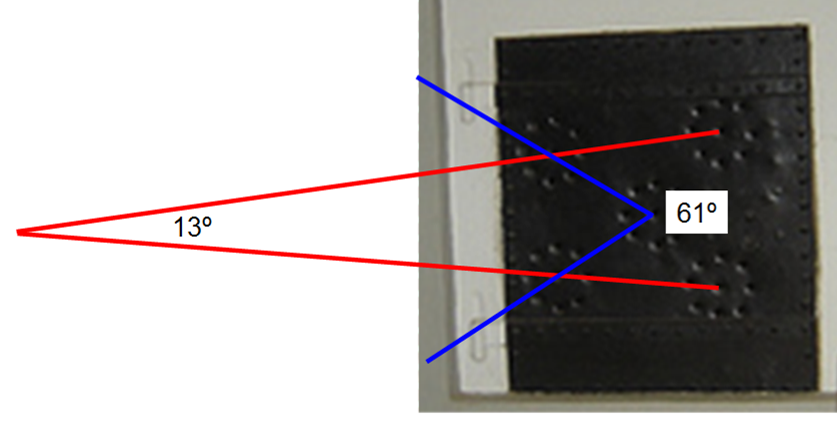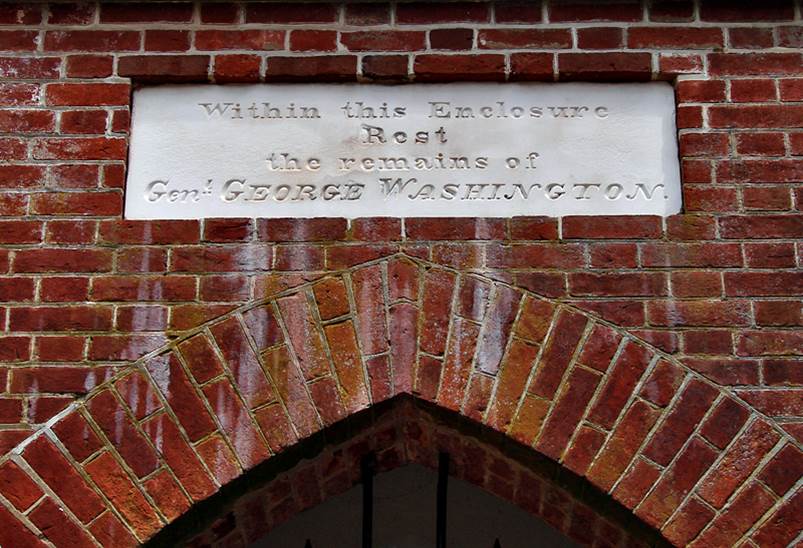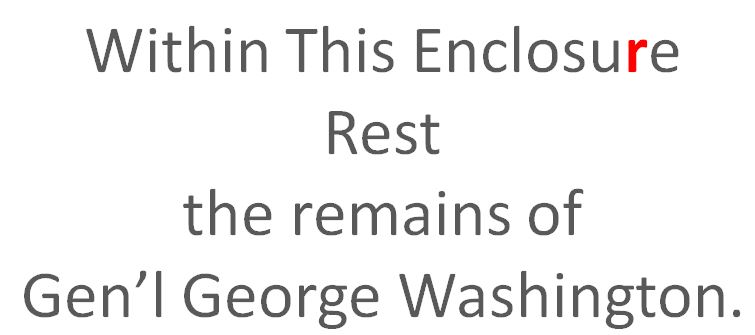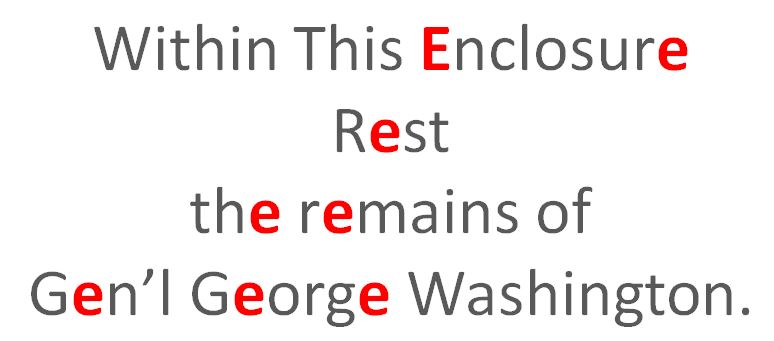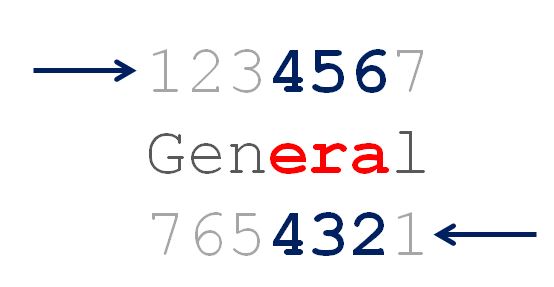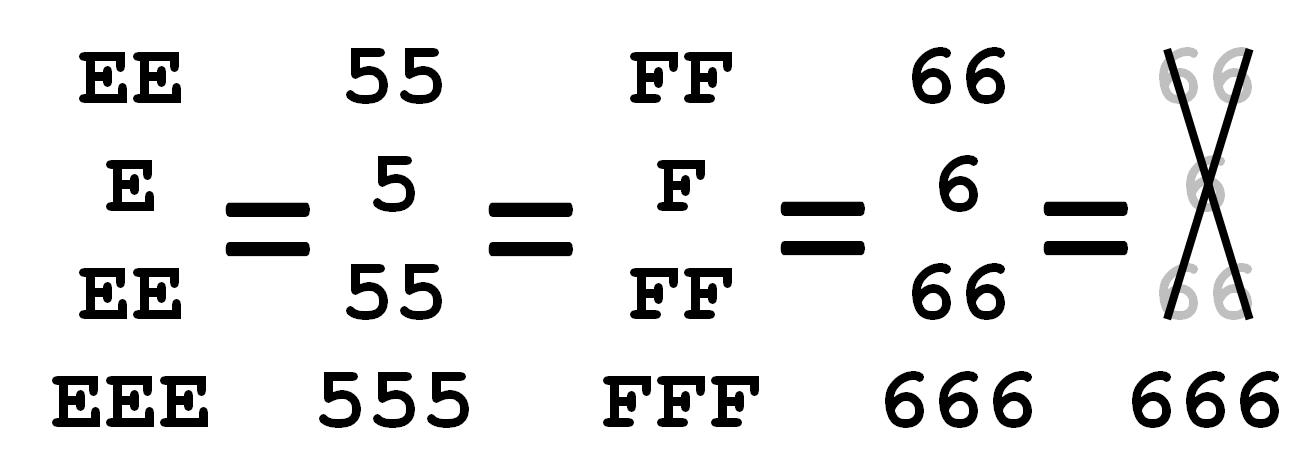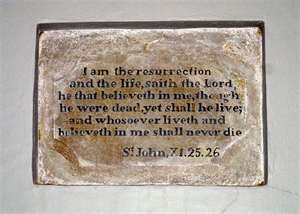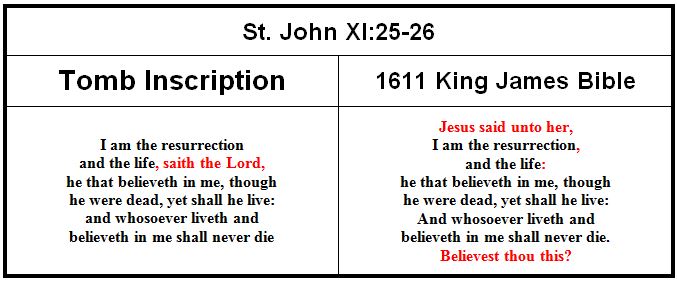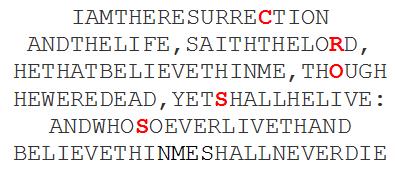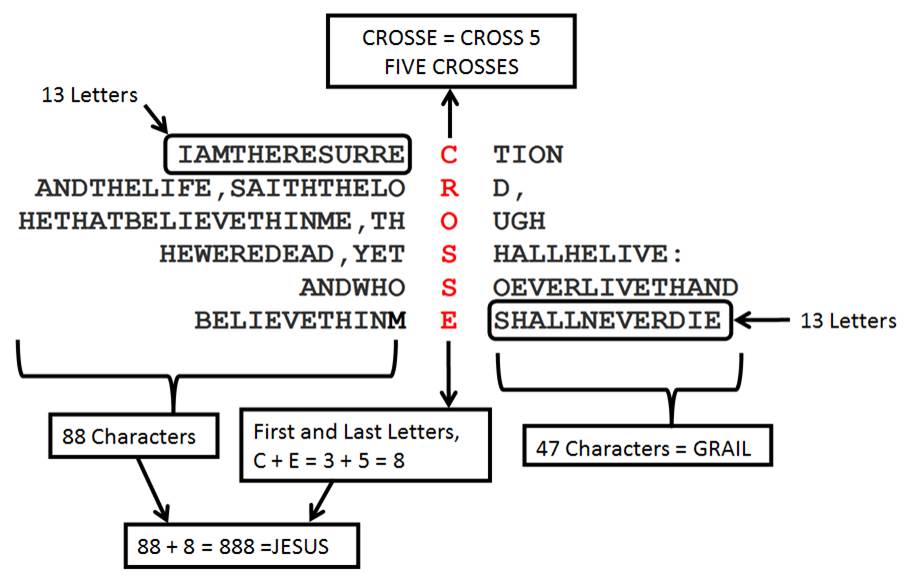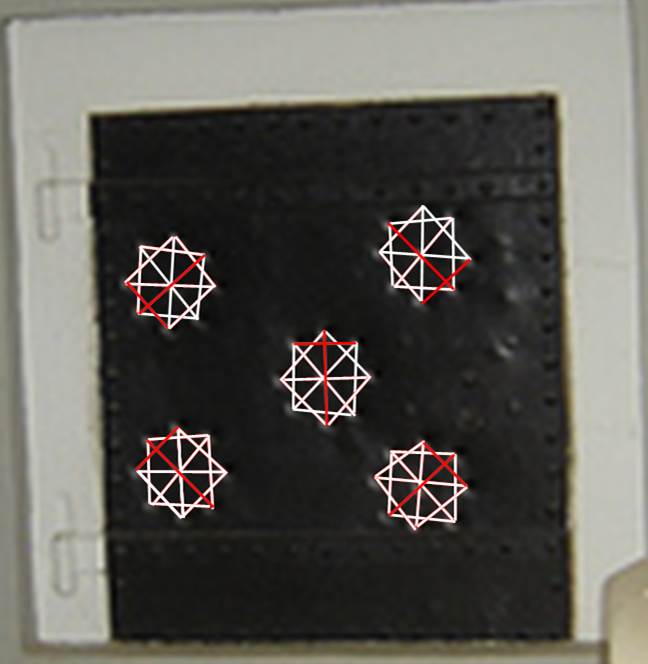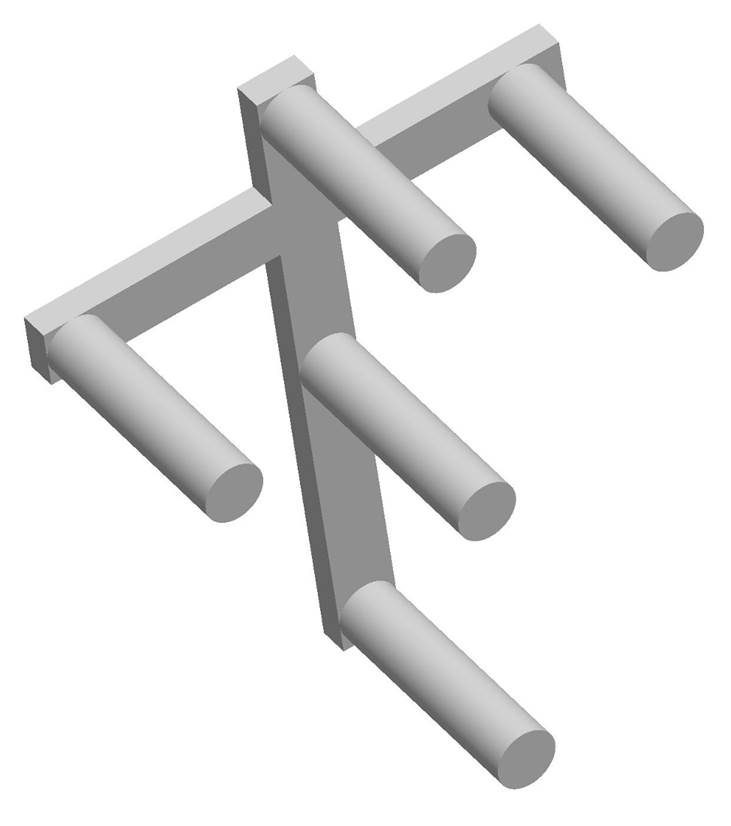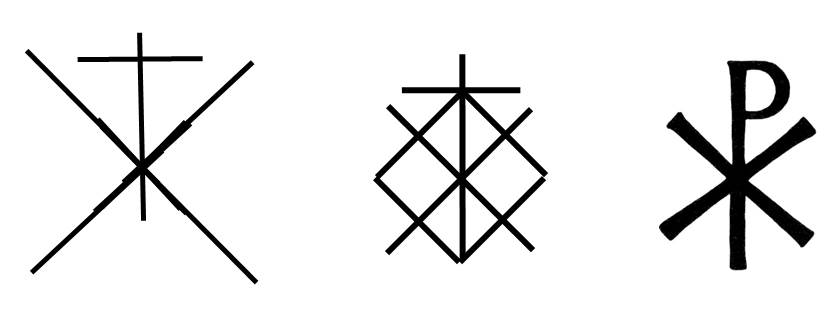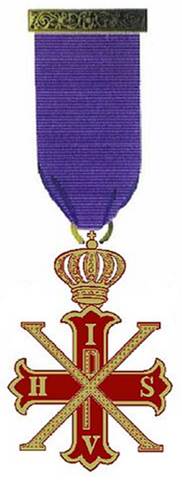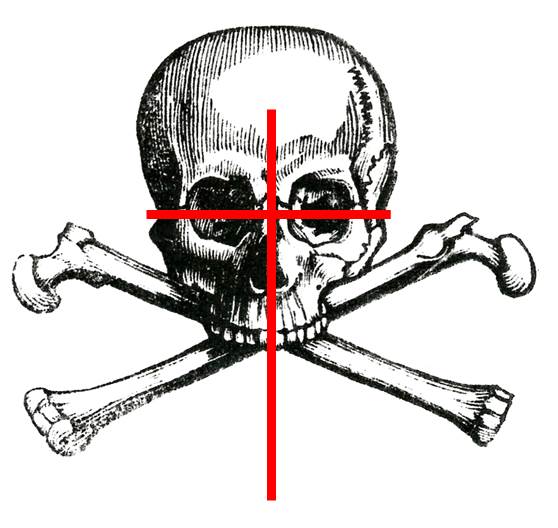The Lock Reveals the Key
“When one door closes, another opens; but we often look so long and so regretfully upon the closed door
that we do not see the one which has opened for us.”
Alexander Graham Bell
To an unsuspecting eye, this innocent little black door at the back of the tomb does not appear to be all that special. However, as you are about to learn, this door holds many secrets. Millions of people have visited the Mount Vernon estate, and almost every visitor eventually finds their way to the tomb of George Washington. They may look at the outside walls or even approach the gated door and take a quick look inside. Most will notice the unusual door on the back wall, but that is usually all they see. Few have ever seen the secrets that are on display. The secret that this door holds has always been visible, but the frame of reference must be changed in order to see the Truth.
The inner door, as it has come to be known, has a covered lock on the right side of the door that would have been typically used with a standard key. If, as some accounts indicate, the key to this door was thrown into the Potomac River in 1837, then how can the door be opened today? It is unlikely that simply using a standard key to open this door, or even attempting to force the door open, would yield anything other than the remains that are supposed to be there. No treasure would be found. To just open the door and find the treasure would be far too easy for someone to find without having to follow the intricately woven trail in the Bible and Washington, DC. If there is something hidden here, there must be another door, or another way to unlock this door.
The door appears to have a series of decorative holes grouped in five circles in the middle of the door. The biggest problem with these holes serving a purely decorative function is the sloppy looking nature of the layout of the holes. In creating a tomb to honor the memory of America’s first President, one would think that the Masons, or whoever built this tomb, could have done a better job of cutting these holes. A closer look at the door, in Figure 2, reveals the sloppy layout of the holes.
There is very little symmetry in the layout of the five groups, nor in the layout of the holes within each group. Although each set of holes may appear similar, they are not the same. The lack of symmetry is a strong indicator that something is not quite right. To learn how to open this door is going to require a little work. But, ultimately, the lock will reveal the key. The center holes of the five groups form an exaggerated version of the Masonic Square and Compass as shown in Figure 3.
The angles of Square and Compass drawn on the door are not the usual angles for this symbol. The Compass has an included angle of only 13 degrees, another possible confirmation of the location, door, and the lock on the door. The Square should be 90 degrees, but it is only 61 degrees here. If the two angles are added together, an interesting clue emerges.
13 + 61 = 74 = JESUS
At this point, it is worth noting that the value of ‘CROSS’ is also 74.
JESUS = CROSS = 74
The shape of a door was found on the layout of Washington, DC using the roads that corresponded to the value of Jesus, 7th and 4th Streets. The angles of the Square and Compass hidden on the inner door of Washington’s tomb, confirm that the correct door has been located by using the Square and Compass to encode the value of JESUS = 74.
Returning to the inscription above the main entrance to the tomb, more secrets are waiting to be discovered. Figure 4 shows the inscription above the main entrance tot he tomb.
The first clue can be found by looking at the letter ‘r’ in ‘Enclosure’, highlighted red in Figure 5.
The ‘r’ is the 18th letter of the inscription, and in standard gematria, R = 18. Because the position matches the value of the letter, it can be interpreted as a clue to look closer or to divide the text at this letter. Following the letter ‘r’, there are 37 letters to the end of the inscription. This confirms that the 1837 completion date of the tomb was more than just coincidence, because 18 X 37 = 666. It was planned to encode the number 666, both in the inscription and in time. Remember that it was established earlier that 666 is the number of Jesus. 1837 is a clue to look for the number 666 in this inscription. The total standard gematria value of the inscription is,
Within This Enclosure Rest the remains of Gen’l George Washington = 671
671 – 666 = 5
671 is close to 666, but not close enough, so what is the message? 671 is 5 more than 666. Since the letter ‘E’ is the 5th letter of the alphabet, it could be a clue to look at the letter ‘E’ in the inscription. The eight E’s in the inscription are highlighted red in Figure 6.
First, notice that there are a total of eight E’s in the inscription. It is important to note here that an abbreviated form of the word ‘General’, ‘Gen’l’, was used in this inscription. It is easy to pass off the abbreviation as sloppy or lazy work on the part of the tomb builder, but why would anyone use an abbreviation on the tomb of a loved one, especially a former President. Moreover, why did they not use the title of ‘President’ instead of ‘General’? Was George Washington’s greatest achievement that of General? The choice to use an abbreviated form of ‘General’, along with the fact that there was plenty of room to write out the entire word, might imply that there is another purpose. The letters ‘era’ are missing from the abbreviated form. The image below shows the positions of the three missing letters from the beginning and the end of the word.
Adding the position numbers from the beginning and end as three-digit numbers gives the value,
456 + 432 = 888
888 is the value of the name of JESUS in the Greek language. The trail to the Grail is paved by the numbers of Jesus and the number 888 hidden in the deleted letters of an abbreviated title that should not have been used on the tomb of a President also confirms that this is the right place.
One of the letters that are missing is the letter ‘E’, which would be the ninth ‘E’ in the inscription, had it not been omitted. There are five sets of holes in the door, and each set consists of 9 holes, one in the center and eight in a circle. The letter ‘E’ refers to the five sets of holes. The eight E’s refer to the eight holes forming the circle in each set of holes. The missing ‘E’ in the abbreviated form of General is referring to the single central hole in each set. Recognizing that ‘E’ can be substituted with the number 5, the E’s on each line of the inscription can be replaced with the number 5, as shown in Figure 8. Spelled out, the number 5 begins with the letter ‘F’, which has a value of 6.
Note that the last line is 555, the height of the Washington Monument. The numbers on each line can be added together to get the following value,
55 + 5 + 55 + 555 = 670
Recall that the total value of the inscription was 671, one more than 670, which is another possible reference to the missing ‘E’ in Gen’l. This might prove to be a clue to leave something out later, but until an attempt is made to open the door, this will have to remain only a possibility. The letter ‘E’ might be pointing to the five sets of holes, but what is the next step? The inscription above the inner door, shown in Figure 9, may help.
Inscribed on a stone above the door are two Bible verses, John 11:25-26. These verses are part of the Biblical story where Jesus raised Lazarus from the dead. He had been dead for four days when Jesus commanded Martha, his sister, to roll away the stone. Martha hesitated, telling Jesus that the body would have started to smell by now. Jesus then tells her in verse 40,
“…Said I not unto thee, that, if thou wouldest believe, thou shouldest see the glory of God?”
This inscription is telling the searcher to believe that the secrets of God are hidden here. Jesus, through His own resurrection, has the power to open every grave, including this one.
Aside from the story that these verses are a part of in the Bible, it is important to compare the inscription to the actual verses of the Bible from which they originate. Although altered, it is clear the verses come from the 1611 King James Bible. For comparison purposes, the two versions are shown in Figure 10. The differences are highlighted red.
The differences between the inscription and the Bible are few, but they are important to note, because a secret has been hidden in the verses on the wall of the tomb. The most obvious difference is that the phrases from the beginning and end of the verses from the Bible were not included in the inscription on the tomb. This is a reference to the first and last, or Jesus. Next, the text, ‘saith the Lord’, was added to the second line of the tomb’s version. Also, some of the punctuation marks have been changed or deleted. The modified text on the tomb appears to be intentional and may offer more information about how to open the door, but first, we need to know what to look for.
Although there has been some debate about the beliefs of George Washington, he was a highly devoted man of God. He prayed every morning and night at a minimum. It is said that he would pray before every meal, making the sign of the cross. As a devoted man of God, there is something conspicuously missing from his tomb. Most Christians prefer to be buried with the cross marking their grave, but where is the cross in George Washington’s tomb?
It is not there. Why? His tomb even includes two Bible verses that speak directly of Jesus and by default, the cross, because Jesus died on the cross. There is no cross on the outside of his tomb, inside the tomb, nor even on the marble sarcophagus that contains his body. George Washington designed the layout of Washington, DC to include a Mall area that is obviously shaped like a cross and that cross was part of the path to finding the door. The cross also forms the basis for the creation of the Masonic Square and Compass. Often times, things can be hidden in plain sight by simply omitting them. Why is the cross missing from the tomb?
The Bible verses above the inner door are designed to confirm the importance of the cross. Starting with the letter ‘C’ in the first line, ‘CROSS’ can be spelled with one letter per line, in what might appear to be a random pattern. Each letter of ‘CROSS’ occurs only once on each of the respective lines. There is only one way to spell ‘CROSS’ with one letter on each of the five consecutive lines of the inscription using the layout above the door as shown in Figure 11.
There are a total of 88 characters, or 83 letters, from the first letter of ‘CROSS’ to the last. The number 83 can be interpreted as three 8’s or 888, which is the value of JESUS in Greek. It is also a clue to target the number 888. The total gematria value of the 83 letters is 879, which is 9 less than 888. The difference between the value of the letters and the target number 888, is a clue that points to the 5 sets of 9 holes on the door. The importance of the holes has already been established, but this is just one more confirmation and it also connects the ‘CROSS” to the holes.
Figure 12 may look a little confusing, but there is a lot of information contained in the inscription. Note that there are 13 letters before the ‘C’ on the first line and after the ‘E’ on the last line. Since 13:13 guided us to the tomb from the Washington Monument, and Jesus is the first and last, look at the letter immediately before the last 13 letters of the inscription, which is the letter ‘E.’ Rearrange the text so that ‘CROSSE’ is aligned vertically and separate the letters on each line both before and after the ‘CROSSE’ to find the hidden message.
There are several confirmations built into this construction. First, the 13 letters before and after the ‘CROSSE’ text, confirms the layout by agreeing with the 13:13 from the capstone of the Washington Monument that led to the tomb. There are 88 characters on the left side of the ‘CROSSE’, and the first and last letters of ‘CROSSE’ have a total value of 8. Combined the 88 and 8 values give the number of JESUS, or 888. The 47 letters to the right of the ‘CROSSE’ letters confirms that this is the location of the ‘GRAIL’, which has a value of 47.
‘CROSSE’ can be interpreted as meaning ‘FIVE CROSSES’ because the letter ‘E” is the fifth letter of the alphabet. The purpose of this encoded message is to tell the searcher that the secret to opening the door is five crosses and it will lead to the Grail. There are 5 sets of holes in the door, so it is logical to look for one cross on each set of holes.
The key to opening the inner door is the cross. The series of holes on the door form a complicated locking mechanism, a type of combination lock. To find the shape of the key, simply connect the dots or holes in each group, so that the shape of a cross is formed. Recall that the cross formed by the Capitol, White House, Lincoln Memorial, and the Jefferson Memorial was slightly skewed or unbalanced, while the actual Mall area formed a perfectly balanced cross shape. There are eight possible crosses on each set of holes on the door. One of the eight crosses in each group is square and balanced, while the other seven are skewed or have unbalanced lengths or angles on the cross bar. The holes that form the balanced shape of a cross are the holes that will need to be used to unlock the door to The Holy Grail. In Figure 13, the seven unbalanced crosses are drawn in white, while the five perfect crosses are highlighted red.
A hypothetical example of what the Key to open the inner door might look like is illustrated in Figure 14. Due to some of the clues related to the letter ‘E’ in the tomb’s inscription, it is possible that the Key could have 4 or 5 cylinders arranged in the shape of a cross that would be inserted into the appropriate holes of the door.
When overlaid, the five balanced crosses form the general shape of the Labarum, or Chi-Rho symbol that was used in battle by the Roman Emperor, Constantine The Great. The Labarum consisted of a long vertical bar or spear with a horizontal cross bar that formed the cross. On top of the cross were the overlaid Greek letters, Chi and Rho, the first two letters of the Greek name of Christ, ΧΡΙΣΤΟΣ. In Figure 15, the left image is formed by overlaying the diagonal crosses at the intersection of the lines that form the cross. The middle image is formed by overlaying the diagonal crosses to form a tilted square, and the right image is the well known Chi-Rho symbol of Christianity.
The Chi-Rho symbol or Labarum is a Masonic emblem in the Order of the Red Cross of Constantine, see Figure 16. While Freemasonry is typically presented as a non-religious, non-denominational fraternal organization, the Order of the Red Cross of Constantine is a totally different matter. To become a member of the Order of The Red Cross of Constantine, an individual must first be a member of Craft Freemasonry and Royal Arch Freemasonry. Initiates must also be Christian and espouse a belief in the Holy Trinity of God. In the Order of The Red Cross of Constantine, the true purpose of Freemasonry is revealed.
The cross at the center of the emblem is a variation of the Templar cross. The letters ‘IHSV’ on the legs of the cross stands for the Latin phrase ‘In Hoc Signo Vinces’, which means ‘In this sign you will conquer.’ This phrase is the rough equivalent of the Greek version that Emperor Constantine is said to have seen in his vision.
Another version of the Chi-Rho symbol popular in Freemasonry and other “secret” organizations is the Skull and Crossbones, shown in Figure 17. Freemasonry teaches that this symbol is to remind us of our mortality, but use a little imagination and you will see the Chi-Rho symbol and the cross. Using the nose and mouth to form the vertical line and the eyes to draw the horizontal line, the cross is revealed in the exact same orientation as it is found on the inner tomb door. The two crossbones represent the letter Chi, and and the four angled crosses on the door.

